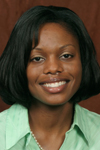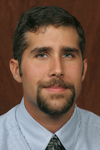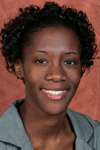
|
STUDENT NEWS |
|
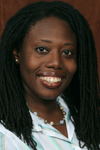 Tanya
Anim, Class of 2010, has received a $10,000 AMBI® Scholarship in Science
& Medicine. Created last year, the national program is designed to
recognize, reward and support African-American and Hispanic women who wish
to pursue a career in science and medicine. A total of $50,000 is divided
equally among five women for tuition, fees and other academic expenses at
any U.S. accredited science or medicine program. Tanya
Anim, Class of 2010, has received a $10,000 AMBI® Scholarship in Science
& Medicine. Created last year, the national program is designed to
recognize, reward and support African-American and Hispanic women who wish
to pursue a career in science and medicine. A total of $50,000 is divided
equally among five women for tuition, fees and other academic expenses at
any U.S. accredited science or medicine program.
“I was completely stunned when I opened my congratulatory letter,” she said recently. “I never really expected to be chosen as one of the scholarship recipients. It was all God’s grace. I am quite humbled by it. It is my hope that in the long term this scholarship will decrease my future financial burden (loan repayment, namely) and enable me to focus on the real reason I decided to seek a career in medicine, and that is to serve the people in greatest need. I thank AMBI most sincerely for their recognition.” For details, visit this Web site. NEW MEMBERS OF GOLD HUMANISM HONOR SOCIETY Daniel Van Durme, M.D., professor and chair of family medicine and rural health, recently announced the members of the Gold Humanism Honor Society from the Class of 2010:
Van Durme then explained the criteria for membership: “The Gold Humanism Honor Society Selection Committee carefully reviewed the nominations from MANY of you. It was encouraging to see so many of our students recognized by faculty from all four years of the curriculum AND their classmates. These ten students rose to the top as true exemplars of humanism by receiving multiple nominations from both faculty and peers in every category of the nomination form demonstrating clinical excellence, service to others, patient-centered approach to care and compassion.” WELCOME, CLASS OF 2013 Those of you who weren’t here during the summer can look forward to meeting the members of the Class of 2013. They looked a little bewildered their first week here, but by now they’ve nearly finished the anatomy course. And soon they’ll be wearing white coats.To read the bios that have been turned in so far, go to the directory at our Web site.
“In My Hands,” by Brittany M. Foulkes (who was on her OB/GYN rotation and got to witness a birth)
“… ‘I can do all things…’ I made it to third year. ‘I can do all things...’ I passed Step 1 of the United States Medical Licensing Examination. ‘I can do all things...’ I made it through this profound experience during my Obstetrics and Gynecology rotation. ‘I can do all things...’ I am one step closer to becoming a doctor. What makes it all real? Having just played a role in bringing someone into the world.” “On Precocious Parenthood,” by David Gonzalez
“… María’s eyes began to tear up. Suspecting that she could be pregnant, I tried to comfort her saying that pregnancy is not the only cause of nausea. She was not comforted. Her tearful eyes told me she would prefer to discuss it only once and with the person that was most likely to have an answer – her doctor. I left the room. María spent the rest of the time with her doctor. “… As a first-year medical student I do not have enough longitudinal
experience to build adequate rapport with patients. At first, they may not
be very forthcoming with their problems, but I will work to become a part of
their lives. And if they choose to become pregnant, I want to help them
progress even in that difficult situation. Hopefully, I can form habits now
to last throughout my career. Maybe teens like María can avoid autumn in the
springtime of their life.”
Conclusions: “Despite the high prevalence of genital HPV infection seen in college-aged adults, these individuals have limited knowledge regarding the role of HPV in the development of cervical cancer. To effectively reduce the number of Americans acquiring a new genital HPV infection, legislators must direct more funds to health education, prevention, and treatment methods. In addition, at-risk groups for developing cervical cancer (i.e., minorities) must be targeted with culturally appropriate public health campaigns. Most importantly, providers must dedicate more time for counseling and patient education to reduce the incidence of HPV in the United States.” ANOTHER TAR WARS CHAMP 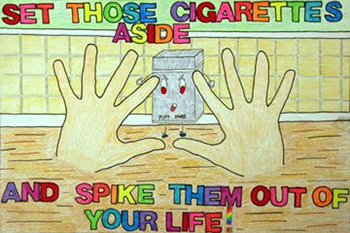 Kara
Monday and Amanda Sautter, Class of 2011, are the latest College
of Medicine students to play a role in what turned out to be the winning
poster in the statewide
Tar Wars poster contest. Tar Wars, which educates children about the
perils of tobacco use, is a program of the American Academy of Family
Physicians. Kara
Monday and Amanda Sautter, Class of 2011, are the latest College
of Medicine students to play a role in what turned out to be the winning
poster in the statewide
Tar Wars poster contest. Tar Wars, which educates children about the
perils of tobacco use, is a program of the American Academy of Family
Physicians.
“Amanda and I did the presentations and activities at Buck Lake Elementary,” Monday said. “We saw all six fifth-grade classes at that school, approximately 130 students. Several members of the College of Medicine family medicine interest group voted on the posters that were submitted, and I believe we wound up sending five to the state competition.” Christie Sain, M.D., a 2005 graduate of the College of Medicine, is statewide Tar Wars coordinator for the Florida Academy of Family Physicians. So she, along with Monday and Sautter, plus Dean John Fogarty (who has helped judge the national contest), traveled to Buck Lake in May to tell fifth-grader Jasmine Asker her poster had been named best in the state. “I am so proud of the work our students do on this program, and the fact that the winner for several consecutive years has come from FSU College of Medicine area elementary schools is worth bragging about,” said Alma Littles, M.D., senior associate dean for medical education and academic affairs. Here’s what Sain wrote in a message to the med students: “I am so proud of you guys and of FSU College of Medicine for winning AGAIN!!!!” |
 |
 |
 |
| E-mail Alumni Affairs Phone: 850-645-9428 | ||
|
|
|
Florida State University
|
College of Medicine
|
Copyright 2013
|
